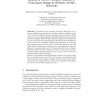Free Online Productivity Tools
i2Speak
i2Symbol
i2OCR
iTex2Img
iWeb2Print
iWeb2Shot
i2Type
iPdf2Split
iPdf2Merge
i2Bopomofo
i2Arabic
i2Style
i2Image
i2PDF
iLatex2Rtf
Sci2ools
MACOM
2010
2010
Quality of Service Oriented Analysis of Cross-Layer Design in Wireless Ad Hoc Networks
Abstract. In wireless ad hoc networks, cross-layer design aims at reducing multiple access interference and thus obtaining a higher spatial reuse. In order to identify the most suitable solution for future wireless systems, we compared the aggregate throughput achieved by two types of cross-layer designs. While the first approach suppresses the interference by power control at the transmitter side, the second cancels interference at the receiver with a technique called multiuser detection. It turned out that applying power control as basis for cross-layer design in very high traffic density scenarios can result in even worse performance than applying no cross-layer design at all. The gains achieved by the multiuser detection based cross-layer design were shown to be based on the interaction between physical and MAC layer, and not only on the more advanced physical layer technique. However, to investigate the provided quality of service, also other criteria have to be taken into account...
| Added | 14 Feb 2011 |
| Updated | 14 Feb 2011 |
| Type | Journal |
| Year | 2010 |
| Where | MACOM |
| Authors | Ulrike Korger, Christian Hartmann, Katsutoshi Kusume, Joerg Widmer |
Comments (0)

